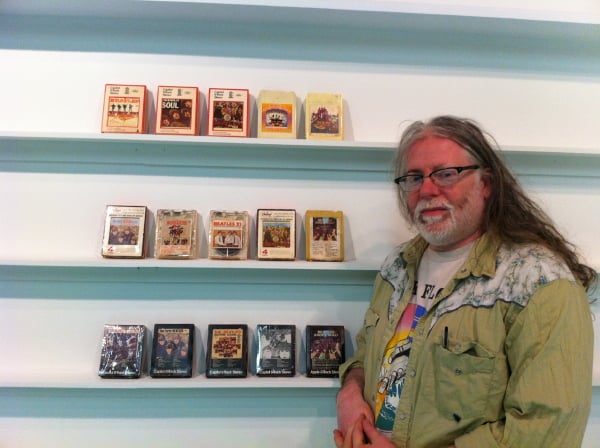On Christmas Day, the first museum devoted to the eight track tape will open in Dallas. The museum is the brain child of Bucks Burnett, who will stock the space with items from his collection. KERA’s Stephen Becker asked the Dallas record producer and musician why the eight track’s legacy is worth preserving:
KERA Radio story:
Audio Player
Bucks Burnett was rummaging through bins at a garage sale in 1988 when something caught his eye: the Beatles White Album on eight track tape.
BURNETT: “And so I’m thinkin’ ‘I’ll get this for 50 cents.’ And I said, ‘How much for the eight track?’ And the guys says, ‘$7.’ And I said, ‘No, the EIGHT TRACK? How much for the EIGHT TRACK?’ And he said, ‘SEVEN DOLLARS.’ I said, ‘Will you take five?’ He said, ‘Put it back in the box.’ I said, ‘OK, wait a minute. Why is this eight track $7?’ And he said, ‘It’s the Beatles. It’s the White Album. Where ya gonna find another one?’ And I gave him seven bucks.”
More than 3,000 8-track tapes later, Burnett’s collection is so large he’s opening a museum in the Deep Ellum Foundation building on Commerce Street to display it. The 700 square foot Eight Track Museum will display between 500-1,000 tapes. The museum will also have an example of every type of physical recorded music from the wax cylinders of the 1800s to the iPod.
BURNETT: “We all have formats we like. We all have formats we hate. And I guarantee you there’s at least 20 formats I’ll have on display you’ve never even heard of. … But the thing is, every single format was someone’s format. That format is what connected them with music.”
Believe it or not, the eight track isn’t even really the 52-year-old Burnett’s format. 1966 model cars were the first to have eight track players. But when Burnett was growing up, his parents drove an Oldsmobile that had a cassette tape deck. He owns a few eight track players, but he doesn’t even listen to his tapes. And that Beatles White Album he found at the garage sale was the first eight track he ever bought.
The collection provides him with another outlet for his music obsession. Wearing a Pink Floyd T-shirt, he brushed his long, stringy grey hair out of his face and sat down on the museum’s bright teal floor to thumb through the clear, plastic boxes that hold his tapes.
BURNETT: “I have a lot of Pink Floyd eight tracks. Everybody remembers Dark Side of the Moon, but how many people have it on a quadraphonic purple eight track? That’s pretty cool.”
Eight track tapes were made from 1965 to 1988, which coincides nicely with classic rock’s hey day. The Rolling Stones and Led Zeppelin are big parts of Burnett’s collection, though he also has tapes by everyone from Talking Heads to Tiny Tim.
The most valuable, though, is a Beatles tape of their 20 Greatest Hits. It was planned to be the last Beatles eight track, but Capitol Records decided not to ship it to stores in 1982. Burnett estimates less than 10 copies survive. He paid $1,000 for his, but it’s hard to estimate its worth because they never come up for sale.
BURNETT: “If the eight track is a thousand times harder to find than the LP, it doesn’t make sense to me that the eight track version should be worth less than the album. I say if anything, the eight track should be worth more than that LP, because there’s terrible odds of even finding it!”
The first exhibition at the Eight Track Museum is called “Conceived in Cars: Birth of the Eight Track – 1965.” It recognizes the auto industry’s role in bringing portable music to the masses. Burnett plans to switch out exhibitions every few months and use money generated from the museum’s $10 admission fee to add to the collection. In fact, he already knows the first tape he’ll buy – the ultra rare Lumpy Gravy by Frank Zappa.
The museum will help grow Burnett’s collection – he’s a collector at heart. But the larger goal is to preserve physical pieces of music history now obsolete in the age of digital music.
BURNETT: “We’re moving on to nearly 120 years of prerecorded, physical formats that were sold to the public. That’s absolutely astounding to me … Are we really going to let all of that go away and disappear just because of a little thing called an mp3? Not on my watch we’re not.”
Photo of eight-track tapes outfront from Woman’s Day







11 Comments